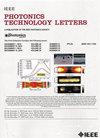基于LNOI平台的八通道混合波长/模分(De)多路复用器
IF 2.5
3区 工程技术
Q2 ENGINEERING, ELECTRICAL & ELECTRONIC
引用次数: 0
摘要
多维复用技术是提高片上通信能力的关键技术。在本文中,我们提出并制作了一种基于绝缘体上铌酸锂(LNOI)平台的8通道混合(de)多路复用器芯片,该芯片可以同时实现模分复用(MDM)和波分复用(WDM)。所提出的(解)复用器包括利用非对称定向耦合器(ADC)的双通道模式(解)复用器和采用一组二阶微环谐振器(MRR)阵列的四通道WDM(解)复用器。为了进一步增加信道数量,将模式解复用器的两个端口互连,从而在保持相同mrr数的情况下使通信容量增加一倍。实验结果表明,该器件实现了−10 dB以下的模间串扰,复用带宽超过50 nm。在1556 ~ 1562 nm的自由频谱范围内,多路复用器8个通道的相邻通道串扰和非相邻通道串扰分别低于- 13 dB和- 27 dB。本研究为LNOI平台上的多维复用技术开辟了新的途径。本文章由计算机程序翻译,如有差异,请以英文原文为准。
An Eight-Channel Hybrid Wavelength-/Mode-Division (De)multiplexer Based on LNOI Platform
Multi-dimensional multiplexing technology is pivotal for enhancing on-chip communication capacity. In this letter, we proposed and fabricated an 8-channel hybrid (de)multiplexer chip based on a lithium niobate on insulator (LNOI) platform, which can simultaneously implement mode-division multiplexing (MDM) and wavelength-division multiplexing (WDM). The proposed (de)multiplexer comprises a two-channel mode (de)multiplexer utilizing an asymmetric directional coupler (ADC) and a four-channel WDM (de)multiplexer employing a set of second-order microring resonator (MRR) arrays. To further increase the number of channels, the two ports of the mode demultiplexer are interconnected, thereby doubling the communication capacity while maintaining the same number of MRRs. Experimental results demonstrate that the device achieves intermode crosstalk below −10 dB with a multiplexing bandwidth of exceeding 50 nm. The adjacent channel crosstalk and the non-adjacent channel crosstalk of the multiplexer’s eight channels are below −13 dB and −27 dB, respectively, over a free spectral range (FSR) from 1556 to 1562 nm. This research paves new avenues in the field of multi-dimensional multiplexing techniques on the LNOI platform.
求助全文
通过发布文献求助,成功后即可免费获取论文全文。
去求助
来源期刊

IEEE Photonics Technology Letters
工程技术-工程:电子与电气
CiteScore
5.00
自引率
3.80%
发文量
404
审稿时长
2.0 months
期刊介绍:
IEEE Photonics Technology Letters addresses all aspects of the IEEE Photonics Society Constitutional Field of Interest with emphasis on photonic/lightwave components and applications, laser physics and systems and laser/electro-optics technology. Examples of subject areas for the above areas of concentration are integrated optic and optoelectronic devices, high-power laser arrays (e.g. diode, CO2), free electron lasers, solid, state lasers, laser materials'' interactions and femtosecond laser techniques. The letters journal publishes engineering, applied physics and physics oriented papers. Emphasis is on rapid publication of timely manuscripts. A goal is to provide a focal point of quality engineering-oriented papers in the electro-optics field not found in other rapid-publication journals.
 求助内容:
求助内容: 应助结果提醒方式:
应助结果提醒方式:


